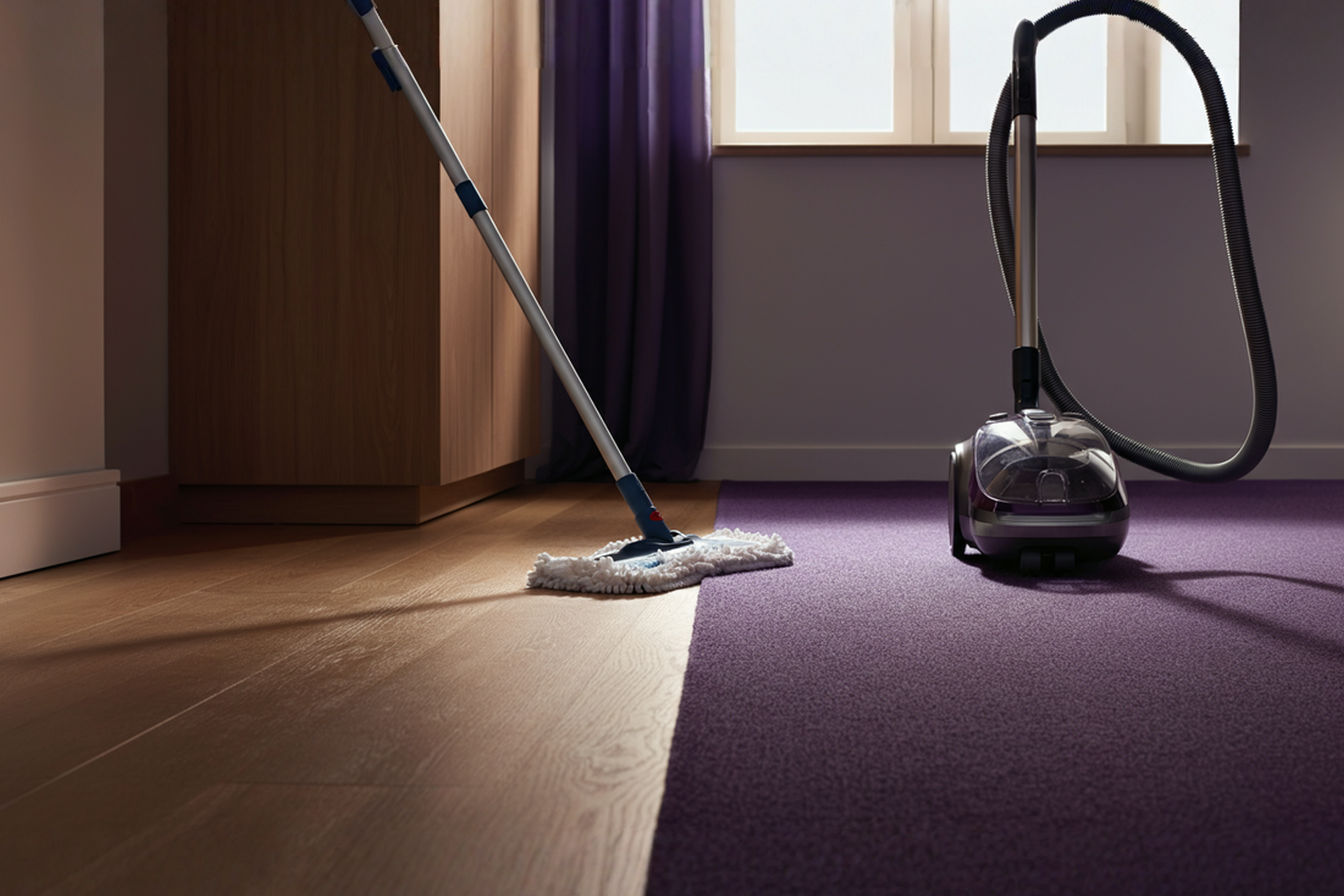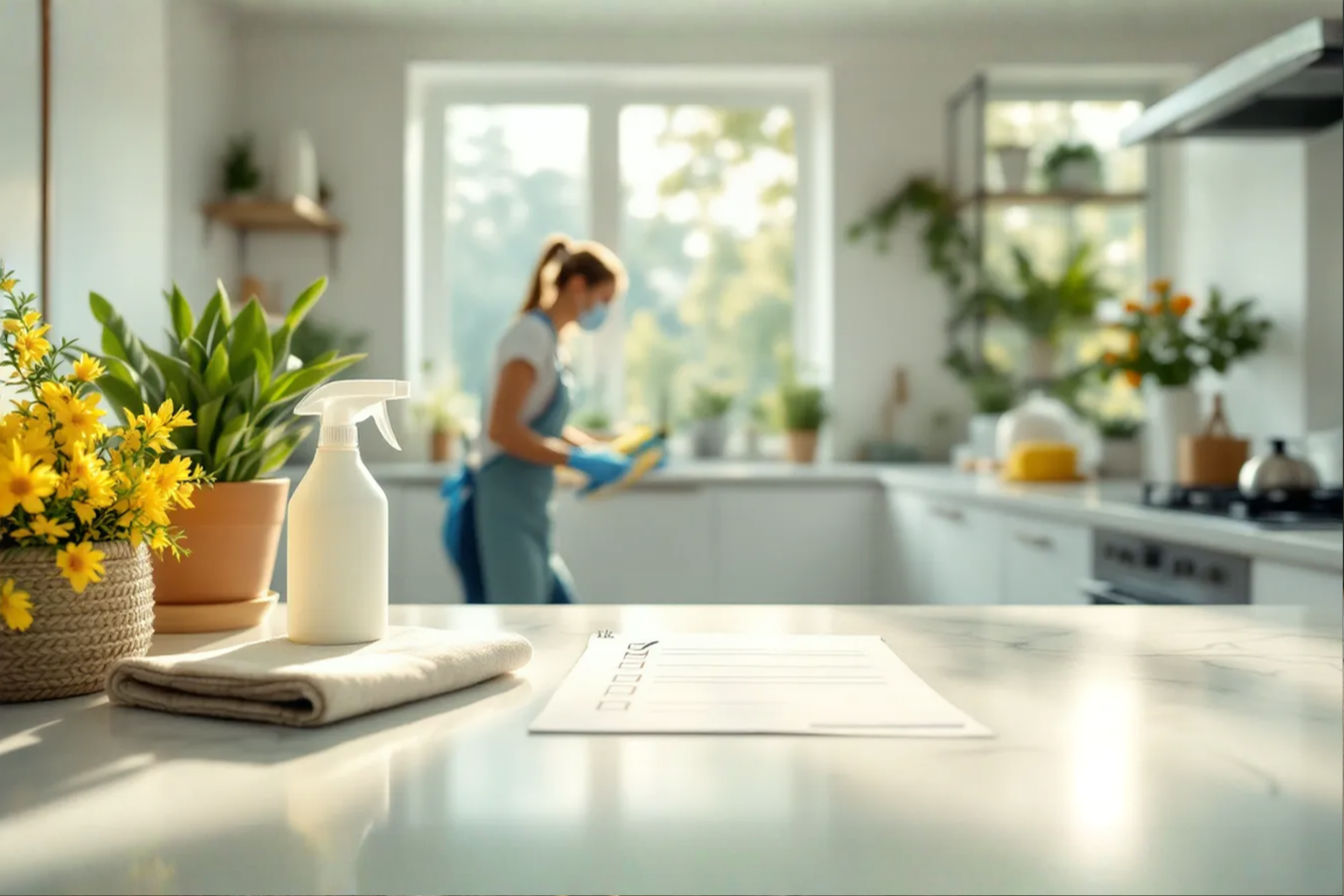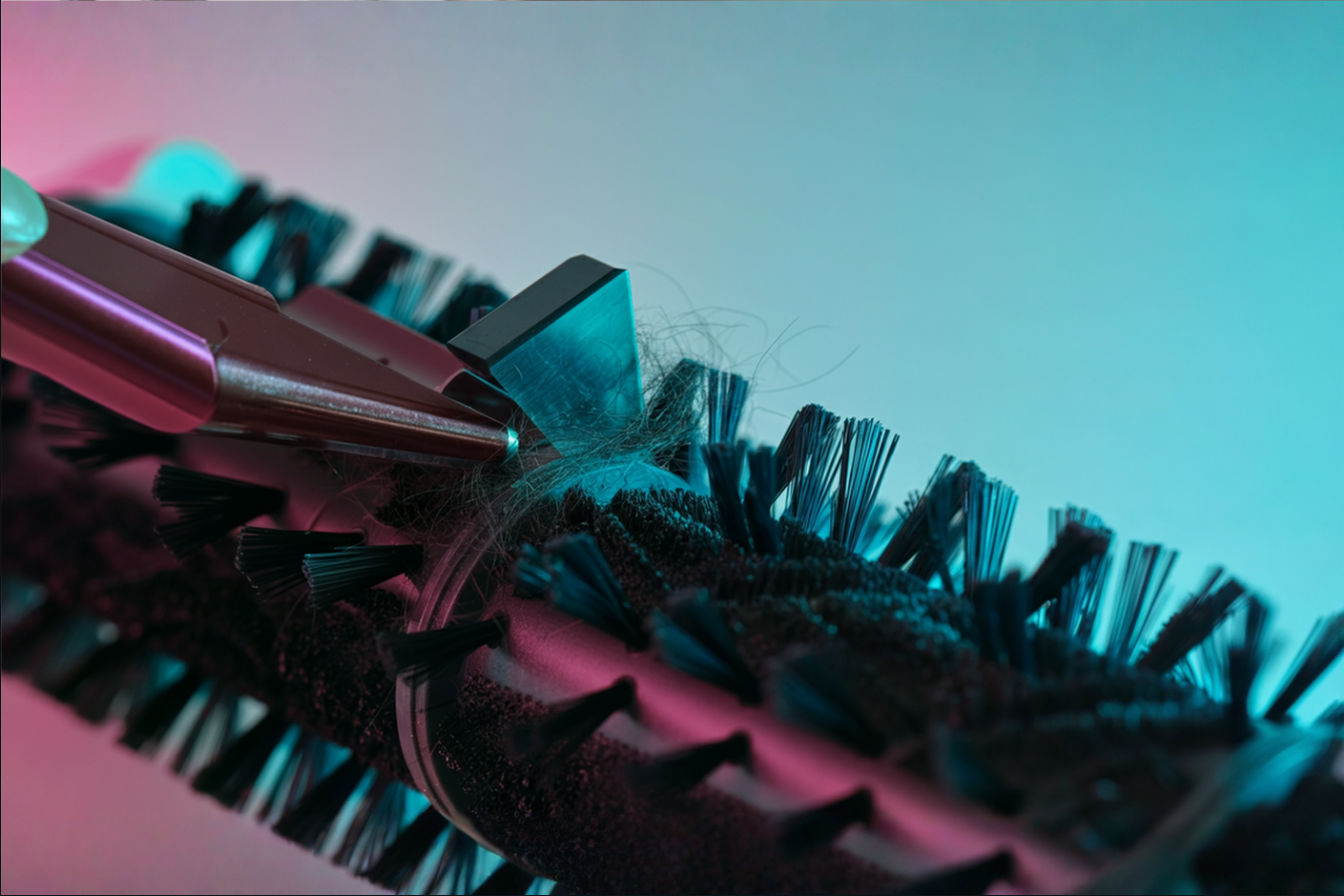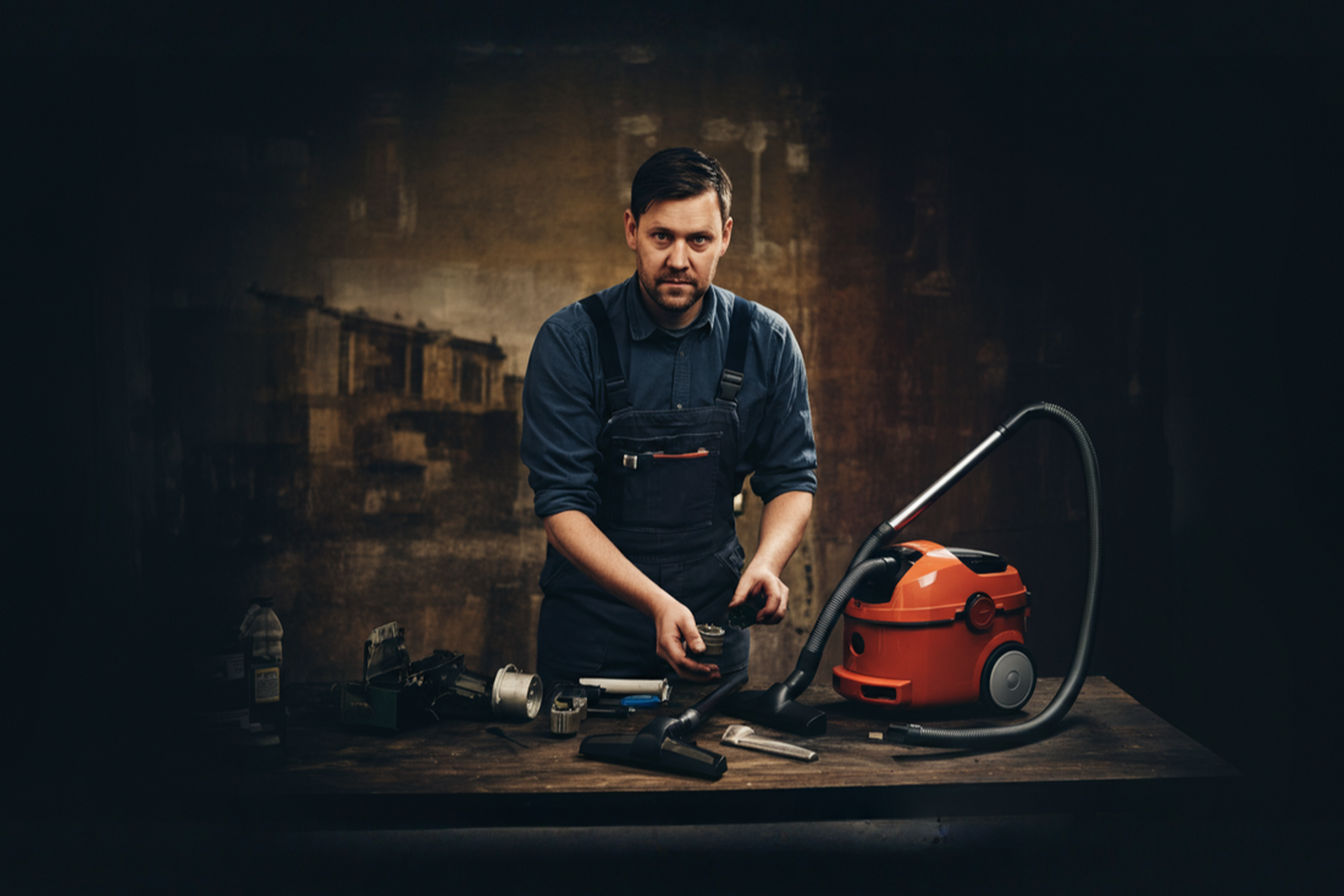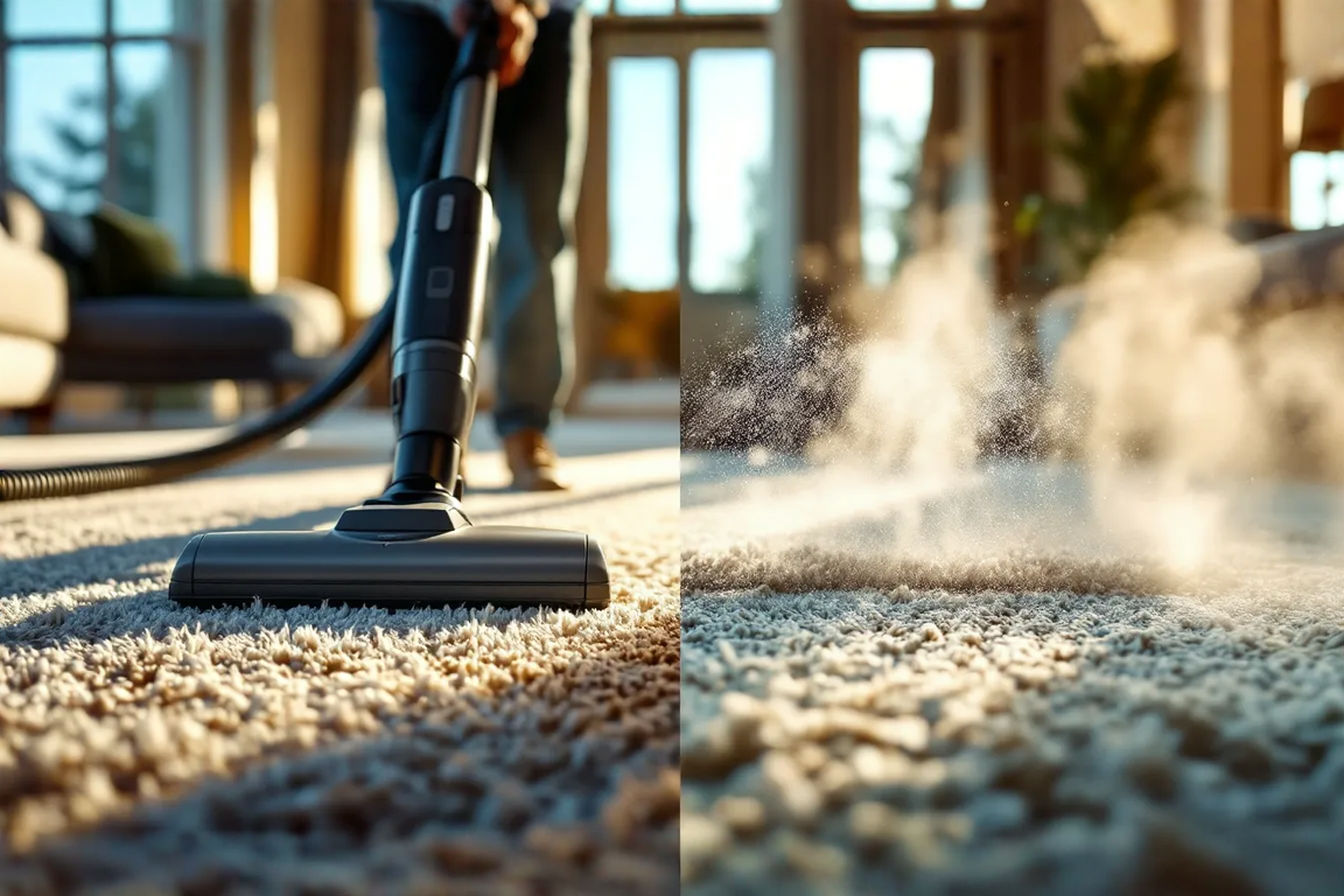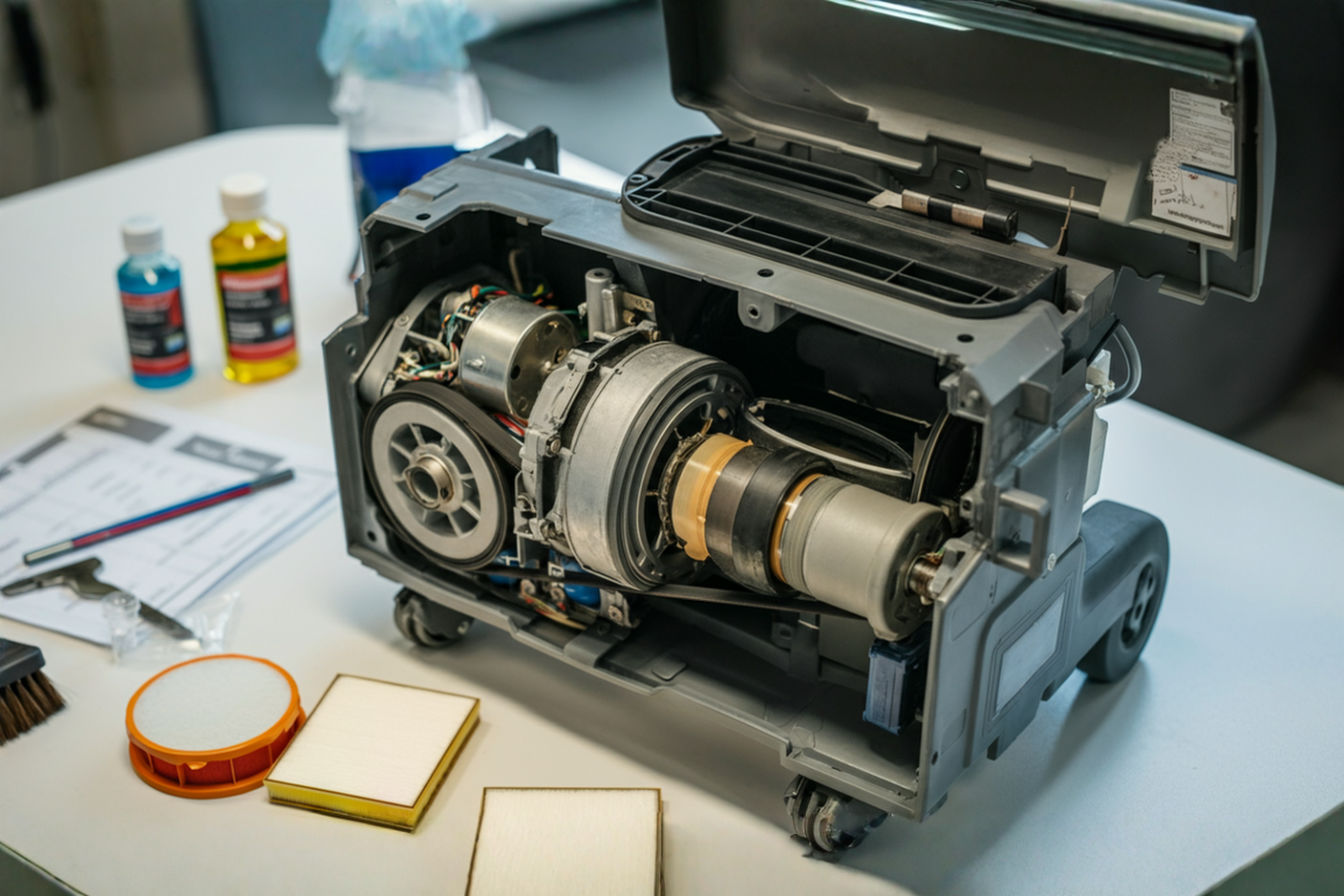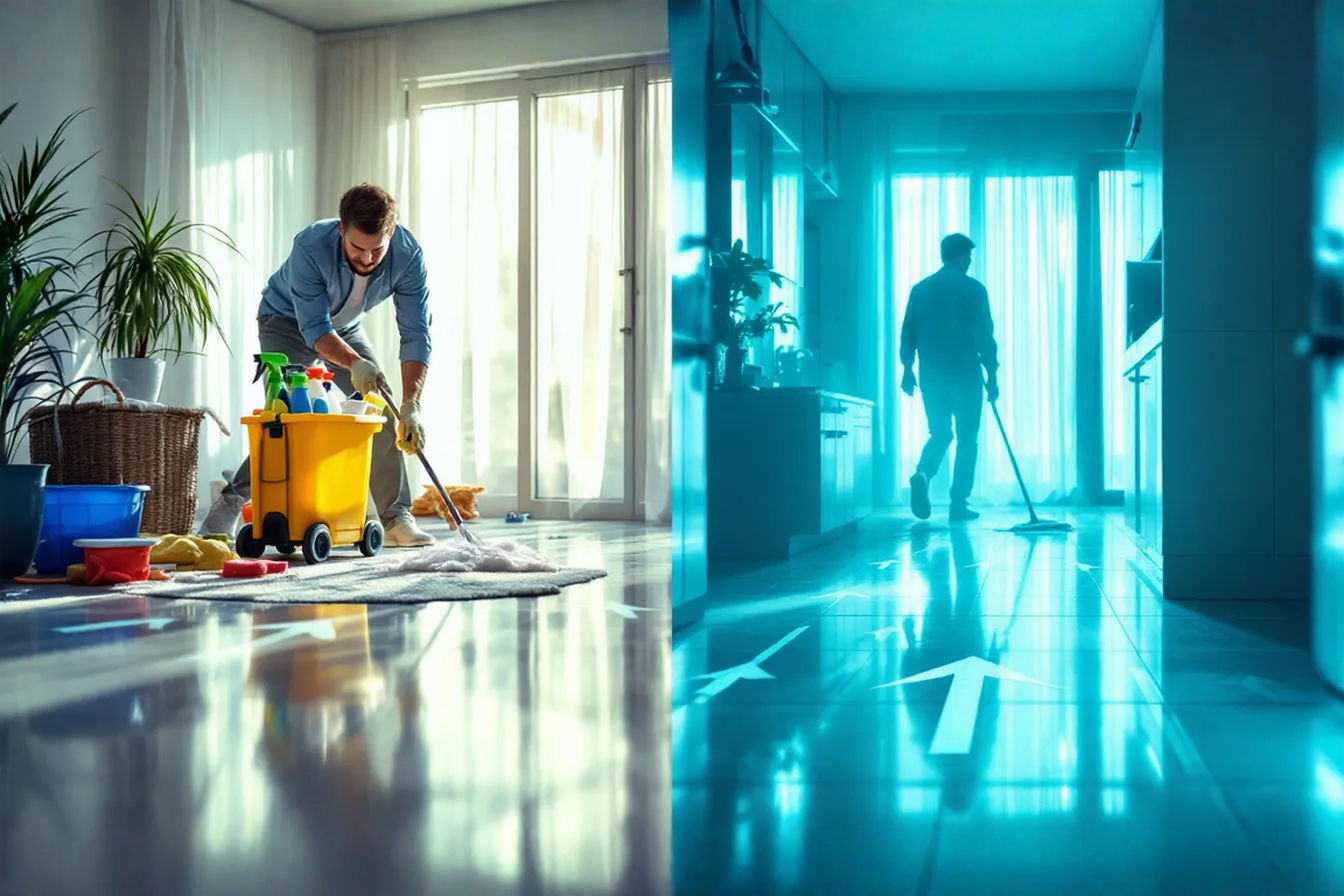The Ultimate Guide to Dust Mop and Vacuum Coordination: Creating a Complete Floor Care System
Learn how to transform random cleaning into a systematic floor care approach by properly coordinating dust mopping and vacuuming, extending floor life while reducing cleaning time and effort.
This post may contain affiliate links. If you make a purchase through these links, we may earn a commission at no additional cost to you.
Walking barefoot across a pristine floor brings a satisfaction that few other household experiences can match. Yet achieving and maintaining that level of cleanliness requires more than occasional random cleaning. It demands a systematic approach that coordinates different cleaning methods, particularly dust mopping and vacuuming, to address the unique needs of various floor surfaces throughout your home.
Proper floor maintenance extends beyond mere aesthetics. Your floors represent one of your home’s largest investments and most frequently used surfaces. They endure constant traffic, collect allergens, and reflect your home’s overall cleanliness. When dust mopping and vacuuming work in harmony as complementary techniques rather than isolated chores, they create a comprehensive floor care system that preserves your flooring investment while providing a healthier living environment.
This guide explores how these two fundamental cleaning methods can work together synergistically, forming the backbone of an effective floor maintenance routine. By understanding when to use each tool, how to sequence your cleaning, and how to adapt your approach for different surfaces, you’ll transform haphazard cleaning sessions into an efficient system that maintains your floors with minimal effort.
Understanding Different Floor Types and Their Needs
Every floor type presents unique cleaning challenges based on its material, texture, and finish. Creating an effective floor care system begins with recognizing these differences.
Hardwood floors demand special attention due to their susceptibility to scratches and moisture damage. These natural surfaces benefit from gentle dust mopping to remove abrasive particles without scratching. Their finish—whether polyurethane, oil, or wax—determines how much moisture they can tolerate during cleaning. Hardwood’s varied grain patterns often trap fine dust that requires specific cleaning strategies to address effectively.
Tile and stone surfaces present different challenges with their grout lines acting as collection points for dirt and debris. The hardness of ceramic, porcelain, and natural stone makes them resistant to damage, but their textured surfaces and grout lines create hiding places for dust and grime. These surfaces withstand more aggressive cleaning but require techniques that address both the tile surface and the recessed grout areas.
Carpeted areas trap dust and allergens within their fibers, making thorough cleaning more challenging. The pile height, fiber type, and construction method all influence how dust and dirt behave when they encounter the carpet. Unlike hard surfaces, carpets store contaminants beneath the visible surface, necessitating deep extraction methods rather than surface cleaning alone.
Multi-surface homes present the greatest coordination challenge as cleaning routines must transition smoothly between different flooring types. The junctions between carpet and hardwood or tile and laminate require thoughtful planning to prevent cross-contamination and ensure complete cleaning. Understanding how dust behaves as it moves across these transitions helps develop more efficient cleaning patterns.
By recognizing these fundamental differences, you can adapt your cleaning approach to address the specific needs of each surface while maintaining consistency in your overall floor care system.
The Floor Care Arsenal: Essential Tools
Creating an effective floor care system requires selecting the right tools for each surface and cleaning task. Your equipment choices form the foundation of your cleaning strategy.
Dust mops come in several varieties, each offering distinct advantages. Microfiber dust mops excel at capturing and holding fine particles through static electricity and microscopic hooks in the material. Traditional cotton dust mops provide coverage for larger areas but may require treatment with dust-attracting sprays. Disposable sheet systems offer convenience at the cost of higher ongoing expenses and environmental impact. The handle design, head size, and material quality significantly influence a dust mop’s effectiveness and ease of use.
Vacuum cleaners vary dramatically in their design and functionality. Upright models deliver strong suction and agitation for carpets but may prove unwieldy on hard surfaces. Canister vacuums offer versatility with interchangeable heads for different floors. Stick and robotic vacuums provide convenience for maintenance cleaning. Features like HEPA filtration, adjustable height settings, and specialized brush designs determine how effectively a vacuum addresses different surface types.
Supplementary tools enhance your floor care system’s effectiveness. Microfiber cloths for detail work, extension wands for reaching under furniture, and specialty attachments for baseboards and corners help create a comprehensive approach. Corner dusters, crevice tools, and edge cleaners address areas that standard dust mops and vacuums might miss.
Quality considerations matter significantly when selecting floor care equipment. Higher-quality tools typically offer better durability, more effective cleaning, and features that improve efficiency. The weight, maneuverability, and ergonomics of your chosen tools affect not just cleaning performance but also your willingness to use them regularly. Investing in better equipment often yields a better cleaning result with less physical effort.
Your floor care arsenal should balance effectiveness, efficiency, and suitability for your specific flooring types. The right combination of tools enables a coordinated approach that addresses each surface’s unique requirements while working together as an integrated system.
The Science Behind Effective Floor Cleaning
Understanding the scientific principles that govern dust behavior and cleaning effectiveness can transform your approach to floor maintenance. This knowledge helps explain why certain techniques work better than others.
Dust and debris behavior varies significantly across different surfaces. On hard floors, particles move freely, easily displaced by air currents or foot traffic. Finer dust often develops an electrostatic charge that causes it to cling to surfaces, while heavier particles settle in low areas or along edges. On carpeted surfaces, particles filter down between fibers, with the carpet structure acting as a three-dimensional filter that traps contaminants at various depths.
The physics of dust mopping versus vacuuming reveals their complementary nature. Dust mopping relies primarily on static electricity and physical contact to collect particles. The mop head generates a slight electrostatic charge that attracts dust, while its fibers physically capture larger debris. Vacuuming, by contrast, uses suction to overcome the forces binding particles to surfaces, combined with agitation to dislodge embedded debris from carpet fibers or floor crevices.
Traffic patterns significantly influence dirt accumulation throughout your home. High-traffic pathways collect the most soil and show wear more quickly than less-used areas. Understanding these patterns allows you to focus cleaning efforts proportionally, giving more attention to areas with greater need. The transition from outdoor to indoor spaces typically creates “soil reservoirs” where outside contaminants first accumulate, making these areas priorities for regular maintenance.
Invisible contaminants and allergens present challenges beyond visible dirt. Pollen, pet dander, dust mites, and microscopic skin cells accumulate on and within floor surfaces. These particles often measure less than 10 microns in size, making them invisible to the naked eye but significant contributors to indoor air quality issues. Their small size allows them to become airborne easily when disturbed, emphasizing the importance of capture-focused cleaning methods rather than those that merely redistribute particles.
By applying these scientific principles to your cleaning approach, you can develop more effective techniques that truly remove contaminants rather than simply moving them around. This knowledge forms the foundation for creating an optimized cleaning sequence that addresses both visible dirt and invisible allergens.
Creating the Optimal Cleaning Sequence
The order in which you perform cleaning tasks significantly impacts your efficiency and results. Developing a logical sequence tailored to your home’s specific needs forms the core of an effective floor care system.
The dust-first approach provides several advantages in most situations. By removing loose surface dust and debris with a dust mop before vacuuming, you prevent scratching hard floors and reduce the burden on your vacuum cleaner. This method excels particularly on hardwood, laminate, and tile floors, where loose particles might be pushed around rather than captured by a vacuum. Begin at the furthest point from the doorway and work methodically toward the exit, using overlapping strokes to ensure complete coverage.
Vacuum-first strategies make more sense in certain circumstances. Heavily soiled carpets benefit from vacuuming first to remove larger debris before addressing fine dust. Areas with significant pet hair or larger particles may also warrant vacuuming as the initial step to remove bulkier debris that might overwhelm a dust mop. When vacuuming first, use slow, deliberate passes to allow the suction and agitation to work effectively.
Room-by-room strategies enhance efficiency by addressing each space’s unique characteristics. Bedrooms typically collect fine dust and benefit from dust mopping followed by focused vacuuming around and under beds. Living rooms with mixed surfaces might require sectional cleaning, addressing hard floors first before moving to carpeted areas. Kitchens need attention to corners and cabinet toe-kicks where crumbs and debris accumulate.
Transitioning between different floor surfaces requires thoughtful planning. When moving from carpeted to hard floors, switch tools or adjust settings to prevent scratching or ineffective cleaning. Working from cleaner areas toward dirtier ones prevents cross-contamination. When dealing with adjacent surfaces, clean the higher surface first (for example, hard floors before lower-pile carpets) to prevent debris from falling onto already-cleaned areas.
The ideal cleaning sequence is not universal but should adapt to your home’s specific layout, flooring types, and traffic patterns. By developing a consistent approach that addresses these variables, you’ll maximize efficiency while achieving better cleaning results.
Dust Mopping Techniques for Maximum Effectiveness
Mastering dust mop techniques transforms this simple tool into a powerful first line of defense against floor contaminants. Proper methodology significantly enhances cleaning efficacy and efficiency.
Proper dust mop preparation begins before touching the floor. For microfiber mops, slightly dampening the head with water can increase its dust-capturing ability through enhanced electrostatic attraction. Traditional yarn mops may benefit from treatment with a commercial dust mop treatment or a homemade solution of water with a few drops of lemon oil. Shake out or vacuum mop heads before use to remove any debris from previous cleaning sessions. Always ensure the mop head is securely attached and lies flat against the floor surface.
Movement patterns greatly influence cleaning effectiveness. The most efficient approach uses overlapping figure-eight motions that keep the mop head in constant contact with the floor. This pattern lifts dust rather than pushing it ahead of the mop. Always maintain a consistent, moderate pace—too slow wastes time, while too fast can create air currents that disperse dust. Keep the mop head on the floor throughout the cleaning process, lifting only when necessary to shake out collected debris.
Corners and hard-to-reach areas require special attention. Fold a flexible mop head to reach tight corners or use the edge of the mop to get alongside baseboards. For areas under furniture or appliances, select a dust mop with a low profile head or one that swivels and bends. Difficult spaces may require supplementing your dust mop with a long-handled duster or microfiber cloth wrapped around a yardstick for targeted reach.
Maintenance of dust mop heads extends their effectiveness and lifespan. Shake out mop heads outdoors after each use to remove loose debris. Microfiber heads should be laundered in warm water without fabric softener, which can coat fibers and reduce their electrostatic properties. Traditional yarn mops may require specialized cleaning according to manufacturer directions. Always ensure mop heads are completely dry before storage to prevent mildew growth and maintain their dust-capturing abilities.
By refining your dust mopping technique, you establish an effective first phase in your floor care routine that removes the majority of loose surface contaminants. This preparation allows subsequent vacuuming to focus on deeper cleaning rather than surface debris removal.
Vacuum Techniques That Complement Dust Mopping
Effective vacuuming builds upon the foundation established by proper dust mopping, focusing on deeper debris extraction and specialized cleaning tasks. Thoughtful technique maximizes your vacuum’s effectiveness in a coordinated floor care system.
Selecting appropriate vacuum settings for each surface prevents damage while ensuring optimal cleaning. On hard floors, disable the rotating brush or switch to a hard floor setting to prevent scratching and scattering of debris. For carpets, adjust the height setting to match the pile depth—too high provides insufficient agitation, while too low creates excessive drag and potential damage. The suction level may also require adjustment when transitioning between different surfaces or addressing delicate area rugs.
Effective vacuuming patterns improve dirt removal rates. Unlike dust mopping’s continuous motion, thorough vacuuming benefits from slower, methodical passes that allow sufficient time for suction to extract embedded particles. Make slightly overlapping passes, first in one direction and then in a perpendicular pattern on high-traffic or heavily soiled areas. This cross-hatching technique addresses carpet fibers from multiple angles, increasing the removal of embedded debris. On hard surfaces, maintain a consistent speed that allows the vacuum to collect rather than scatter loose particles.
Attachments enhance cleaning performance by addressing specialized areas. Crevice tools remove debris from tight spaces along baseboards and in corners where dust naturally collects. Upholstery attachments can clean furniture edges and stairs effectively. Extension wands reach under furniture without requiring heavy lifting. Edge cleaning features help address the perimeter of rooms where dust mop heads might not reach effectively. Dusting brushes can be used for baseboards and trim work that affects floor cleanliness.
Vacuum maintenance significantly impacts performance. Empty the dust collection container or replace bags when they reach 70% capacity to maintain optimal suction. Regularly inspect and clean filters according to manufacturer guidelines—clogged filters dramatically reduce efficiency. Check rotating brushes for hair and thread buildup that can impair agitation effectiveness. Keep wheels clean to prevent transferring dirt from one area to another. This routine maintenance ensures consistent performance that complements your dust mopping efforts.
When properly executed, vacuuming addresses the deeper cleaning needs that dust mopping alone cannot accomplish. Together, these techniques form a powerful combination that manages both surface contaminants and embedded debris across all your floor surfaces.
Developing a Comprehensive Floor Care Schedule
Consistent timing and appropriate frequency form the backbone of an effective floor maintenance program. A well-structured schedule balances thoroughness with practicality.
Daily quick-maintenance routines prevent accumulation of dust and debris that can damage floors over time. These brief sessions focus on high-traffic areas and visible debris. A quick pass with a dust mop in entryways, kitchen areas, and main hallways takes minimal time but provides significant preventive benefits. For households with pets or allergy sufferers, daily attention to primary living areas helps manage hair and dander. These maintenance sessions typically require only 5-10 minutes but dramatically reduce the effort needed during deeper cleaning.
Weekly deep cleaning protocols address the entire floor surface more thoroughly. This comprehensive cleaning includes moving lightweight furniture, using attachments for edges and corners, and paying special attention to areas under furniture and along baseboards where dust accumulates. The weekly schedule should rotate focus areas, perhaps dedicating extra attention to bedrooms one week and living areas the next, to maintain overall cleanliness without requiring excessive time commitment.
Monthly and seasonal maintenance tasks complement your regular routine. Monthly tasks might include moving heavier furniture to clean underneath, addressing less-used areas like guest rooms or formal dining spaces, and checking for any developing issues with your flooring. Seasonal considerations include more frequent cleaning during high pollen periods, additional attention to entryways during snowy or rainy seasons, and deeper cleaning before and after holiday gatherings or major events.
Adapting schedules for special household needs ensures your floor care system addresses your unique situation. Homes with young children may require more frequent attention to play areas and crawl spaces. Pet owners benefit from focusing on areas where animals rest and pathways they frequently travel. Allergy sufferers might need more emphasis on HEPA filtration and more frequent vacuuming of soft surfaces where allergens accumulate. Creating a personalized schedule that acknowledges these specific needs increases both effectiveness and consistency.
The ideal floor care schedule integrates seamlessly into your overall household routine, making it more likely that you’ll maintain the system consistently. Rather than viewing floor care as isolated tasks, incorporate elements into your existing patterns—dust mopping while waiting for coffee to brew or vacuuming after dinner cleanup. This integration helps establish floor care as a natural part of home maintenance rather than a burdensome chore.
Special Considerations for Challenging Situations
Certain household circumstances create unique floor care challenges that require adapted approaches within your coordinated cleaning system.
Pet-friendly floor care strategies address the additional challenges of fur, dander, tracked litter, and occasional accidents. Selecting tools specifically designed for pet hair removal, such as rubber-bristled brooms or vacuum attachments with enhanced agitation, improves efficiency. Establishing more frequent cleaning zones around pet beds, feeding areas, and favorite resting spots prevents buildup. Hard surface areas near litter boxes benefit from dust mopping twice daily, while entryways where pets enter after outdoor activities require special attention to prevent tracking. Consider adding a pet-specific pre-filter to your vacuum to prevent clogging from excessive hair.
High-traffic area maintenance requires targeted approaches for zones experiencing concentrated wear. These areas benefit from preventive measures such as strategically placed mats at entry points and transition areas between different flooring types. The cleaning frequency for main pathways through your home may need to be double or triple that of less-used spaces. Consider using different tools for these areas—perhaps a dedicated dust mop for daily quick passes through corridors and entryways, reserving your primary cleaning tools for more comprehensive sessions.
Spills and spot cleaning necessitate immediate attention to prevent staining and damage. Keep appropriate cleaning supplies accessible in various locations throughout your home to enable prompt response. For hard surfaces, blotting with microfiber cloths removes most liquid spills without spreading the contamination. Carpet spills require blotting followed by appropriate spot treatment based on the spill type. Integrate these spot-cleaning tools into your overall system, perhaps storing them alongside your regular dust mop and vacuum attachments for quick access.
Allergy-friendly cleaning approaches emphasize particle removal rather than redistribution. HEPA-filtered vacuums capable of capturing particles as small as 0.3 microns become essential for maintaining healthy air quality. Microfiber dust mops that trap rather than scatter allergens offer significant advantages over traditional cotton versions. Cleaning progression should always move from higher to lower surfaces to prevent redistributing dust and allergens onto already-cleaned areas. Increasing both frequency and thoroughness during high pollen seasons helps manage seasonal allergies through environmental control.
By adapting your coordinated floor care system to address these specific challenges, you create a more responsive and effective approach. This customization ensures that your cleaning routine addresses your household’s unique needs while maintaining the fundamental principles of effective dust mopping and vacuuming coordination.
Troubleshooting Common Floor Care Problems
Even well-designed floor care systems occasionally encounter challenges. Recognizing and addressing these common issues maintains your system’s effectiveness over time.
Persistent dust issues often indicate gaps in your cleaning approach. If dust reappears shortly after cleaning, check for overlooked sources such as ceiling fan blades, air vents, or textiles that shed fibers. Ensure your dust mop head is clean and properly treated to capture rather than spread particles. Consider adjusting your cleaning sequence—persistent dust may indicate that your vacuum is redistributing particles rather than capturing them, suggesting a need to dust mop after vacuuming instead of before. Examine your HVAC filters and replace them if clogged, as they contribute significantly to dust circulation throughout your home.
Vacuum marks or damage on floors typically result from improper settings or techniques. Scratches on hardwood or laminate suggest the brush roll may be engaged when it should be disabled, or debris might be trapped in the vacuum head. Carpet pile distortion often occurs when the height adjustment is set too low, creating excessive suction that pulls fibers. Resolve these issues by adjusting your vacuum’s settings for each surface type and inspecting the underside of the vacuum head regularly for embedded particles that could cause scratching.
Static electricity challenges arise particularly in dry environments and with certain flooring materials. This static can cause dust to cling to floors or be repelled from cleaning tools. Address this by maintaining appropriate humidity levels in your home during dry seasons—even a small room humidifier can make a difference. For microfiber mops, slightly dampening the head reduces static while enhancing dust capture. Some commercial dust mop treatments also help neutralize static charges during cleaning.
Stubborn dirt or stains that resist your regular cleaning routine may require targeted intervention. For hardwood floors, areas with built-up grime might need treatment with a manufacturer-approved wood cleaner. Tile grout lines often require periodic deep cleaning with a small brush to maintain appearance. For carpets, professional steam cleaning every 12-18 months complements your regular maintenance by addressing deeply embedded soil that normal vacuuming cannot remove. Integrate these occasional deep-cleaning measures into your overall system as scheduled maintenance rather than emergency responses.
By approaching these challenges systematically, you can refine your floor care routine to address specific issues while maintaining the core coordination between dust mopping and vacuuming. This troubleshooting mindset helps your system evolve to meet changing needs and overcome obstacles that might otherwise diminish your results.
Advanced Strategies for Floor Care Efficiency
Once you’ve established your basic coordinated floor care system, implementing advanced techniques can further enhance efficiency and results.
Time-saving techniques enable more thorough cleaning within limited schedules. Strategic furniture placement that allows for easy cleaning access reduces the time spent moving obstacles. Implementing the “top-down” approach—dusting high surfaces before addressing floors—prevents rework. Establishing a consistent cleaning pattern through your home eliminates decision fatigue and builds muscle memory that increases speed naturally. Consider timing your cleaning sessions to identify opportunities for improvement, much like athletes track their performance to enhance efficiency.
Zone cleaning approaches divide larger homes into manageable sections addressed on different days. Rather than attempting to clean all floors in one session, focus on complete cleaning of specific zones—perhaps bedrooms on Monday, living areas on Wednesday, and utility spaces on Friday. This approach ensures thorough attention to each area while preventing the discouragement that comes from attempting to clean too much in limited time. Each zone receives proper dust mopping and vacuuming in appropriate sequence, maintaining the coordinated approach in manageable segments.
Coordinating with other household tasks creates natural efficiency. Dust mop kitchen floors while waiting for the dishwasher to finish, addressing two tasks in parallel. Schedule vacuum maintenance—such as emptying canisters or changing bags—to coincide with trash collection day, streamlining disposal. Integrate floor care into existing routines by dust mopping a room while waiting for the shower to warm up or vacuuming while listening to a weekly podcast, creating positive associations with cleaning activities.
Leveraging technology enhances modern floor care systems. Robot vacuums can maintain floors between your more thorough manual sessions, particularly in high-traffic areas that benefit from daily attention. Smart home integration allows scheduling vacuum runs when the house is empty, maximizing convenience. Apps that track cleaning schedules provide reminders and maintain consistency. Newer vacuum models with dirt detection technology focus additional cleaning passes on areas with more soil, optimizing cleaning effort distribution automatically.
These advanced strategies transform your floor care system from a basic maintenance routine to an optimized approach that delivers better results with less effort. By continually refining your methods, you’ll discover personalized efficiencies that enhance your specific situation while maintaining the fundamental coordination between dust mopping and vacuuming.
Sustainable and Eco-Friendly Floor Care
Incorporating environmental consciousness into your floor care system benefits both your home and the larger ecosystem without sacrificing cleaning effectiveness.
Environmentally conscious tool selection forms the foundation of sustainable floor care. Choose dust mops with washable, reusable heads rather than disposable systems that generate ongoing waste. Look for vacuums designed for longevity and repair rather than planned obsolescence, with readily available replacement parts. Consider tools made from sustainable materials—bamboo handles instead of plastic, for example—that reduce environmental impact without compromising functionality. Energy-efficient vacuum models consume less electricity while delivering equivalent cleaning performance, reducing your carbon footprint during regular use.
Reducing disposable product usage significantly decreases household waste. Replace disposable dust sheets with washable microfiber mop heads that can be reused hundreds of times before replacement. Select vacuum models with washable filters rather than disposable versions that require frequent replacement. For occasional deep cleaning, rent professional-grade equipment instead of purchasing single-use products. These choices maintain cleaning effectiveness while dramatically reducing the waste stream associated with floor maintenance.
Natural cleaning solutions provide effective alternatives to harsh chemicals for most floor care needs. A solution of equal parts water and white vinegar safely cleans most hard surfaces without harmful residues. Baking soda works effectively as a carpet deodorizer and gentle abrasive for stubborn spots on resilient flooring. Essential oils like tea tree or lavender add antibacterial properties and pleasant scents to homemade cleaning solutions without the synthetic fragrances that can trigger respiratory issues. These natural alternatives protect indoor air quality while reducing chemical manufacturing and packaging waste.
Extending floor lifespan through proper care represents perhaps the most significant environmental contribution. Floors maintained with appropriate, coordinated cleaning require replacement less frequently, preventing the resource consumption and waste generation associated with new flooring installation. Protecting wood floors from scratching through proper dust removal prevents the need for premature refinishing. Carpets maintained with regular vacuuming last years longer before replacement becomes necessary. This preservation focus supports sustainability through reduced consumption rather than merely changing product choices.
By integrating these sustainable practices into your coordinated floor care system, you align environmental responsibility with effective home maintenance. These approaches often deliver financial benefits through reduced product purchases and extended flooring life, demonstrating that ecological mindfulness can enhance rather than detract from your cleaning results.
Conclusion
Coordinating dust mopping and vacuuming creates a synergistic floor care system greater than the sum of its parts. This systematic approach transforms disconnected cleaning tasks into a cohesive maintenance program that preserves your flooring investment while creating a healthier home environment.
The foundation of this system rests on understanding how these complementary techniques address different aspects of floor maintenance. Dust mopping excels at removing loose surface particles through static attraction and physical wiping, while vacuuming provides the suction and agitation necessary to extract embedded debris from carpets and crevices. When sequenced properly and executed with attention to technique, these methods work together to manage the full spectrum of floor contaminants.
Implementing this coordinated approach yields both immediate and long-term benefits. Initially, you’ll notice visibly cleaner floors with less effort as each tool focuses on the tasks it performs best. Over time, the systematic removal of abrasive particles before they can damage surfaces extends your flooring’s lifespan, postponing costly replacements or refinishing. The consistent removal of allergens and contaminants also contributes to improved indoor air quality and overall health.
Perhaps most importantly, a well-designed floor care system becomes sustainable through its integration into normal household routines. Rather than viewing floor cleaning as an occasional intensive project, this approach emphasizes regular maintenance appropriately distributed across the week. This consistency prevents the accumulation problems that make cleaning feel overwhelming and discouraging.
By applying the principles outlined in this guide, you can develop a personalized floor care system that addresses your home’s specific needs while maintaining the fundamental coordination between dust mopping and vacuuming. This thoughtful approach transforms floor maintenance from a dreaded chore into a manageable routine that consistently delivers exceptional results.

